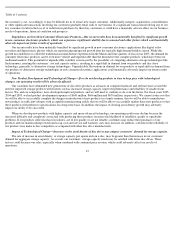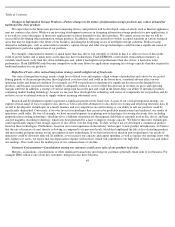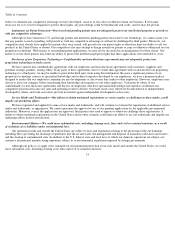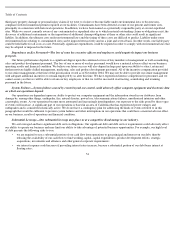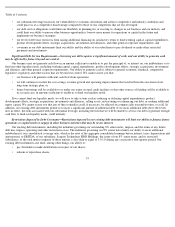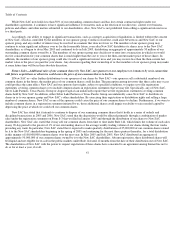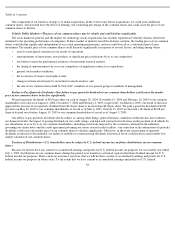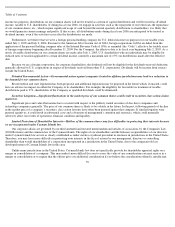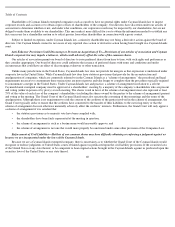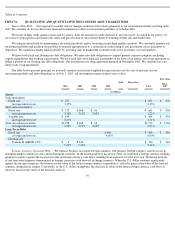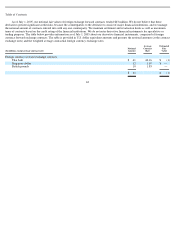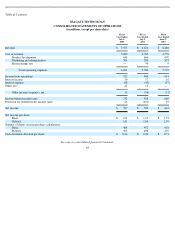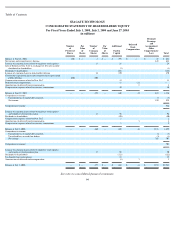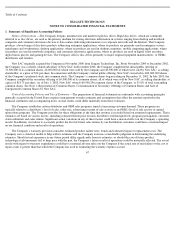Seagate 2004 Annual Report Download - page 60
Download and view the complete annual report
Please find page 60 of the 2004 Seagate annual report below. You can navigate through the pages in the report by either clicking on the pages listed below, or by using the keyword search tool below to find specific information within the annual report.
Table of Contents
While New SAC now holds less than 50% of our outstanding common shares and has lost certain contractual rights under our
shareholders agreement, it continues to have significant influence over matters such as the election of our directors; control over business,
policies and affairs; and other matters submitted to our shareholders. Also, New SAC is not prohibited from selling a significant interest in us
to a third party.
Accordingly, our ability to engage in significant transactions, such as a merger, acquisition or liquidation, is limited without the consent
of New SAC, which is controlled by the members of our sponsor group. Conflicts of interest could arise between us and New SAC or our
sponsor group, and any conflict of interest may be resolved in a manner that does not favor us. The members of our sponsor group may
continue to retain significant influence over us for the foreseeable future, even after New SAC distributes its shares in us to the New SAC
shareholders, as it began to do in May 2005 and continued to do in July 2005, distributing an aggregate of approximately 50 million of our
outstanding common shares owned by it. The members of our sponsor group may decide not to enter into a transaction in which you would
receive consideration for your common shares that is much higher than the cost to you or the then-current market price of those shares. In
addition, the members of our sponsor group could elect to sell a significant interest in us and you may receive less than the then-current fair
market value or the price you paid for your shares. Any decision regarding their ownership of us that members of our sponsor group may make
at some future time will be in their absolute discretion.
Future Sales—Additional sales of our common shares by New SAC, our sponsors or our employees or issuances by us in connection
with future acquisitions or otherwise could cause the price of our common shares to decline.
If New SAC or—after further distributions to our sponsors of our shares by New SAC—our sponsors sell a substantial number of our
common shares in the future, the market price of our common shares could decline. The perception among investors that these sales may occur
could produce the same effect. New SAC and our sponsors have rights, subject to specified conditions, to require us to file registration
statements covering common shares or to include common shares in registration statements that we may file. Specifically, any of New SAC,
Silver Lake Partners, Texas Pacific Group or August Capital can unilaterally require that we file registration statements covering common
shares held by New SAC. In addition, either Silver Lake Partners or Texas Pacific Group can unilaterally cause New SAC to distribute its
shares in us to our sponsor group and New SAC’s other shareholders. By exercising their registration or distribution rights and selling a large
number of common shares, New SAC or any of the sponsors could cause the price of our common shares to decline. Furthermore, if we were to
include common shares in a registration statement initiated by us, those additional shares could impair our ability to raise needed capital by
depressing the price at which we could sell our common shares.
New SAC has stated that it intends to continue to dispose of our remaining common shares that it holds in a series of orderly and
disciplined transactions in 2005 and 2006. New SAC stated that the disposition would be effected primarily through a combination of market
sales under the registration statement on Form S-3 that we filed in January 2005 and through the distribution of our shares to New SAC
shareholders. New SAC also stated that it may sell our common shares from time to time under Rule 144, which limits the volume of such sales
in any 90-day period to the greater of 1% of our outstanding shares or the average weekly trading volume of our shares during the four weeks
preceding any trade. In particular, New SAC stated that it expected to make quarterly distributions of 25,000,000 of our common shares owned
by it to the New SAC shareholders beginning in the spring of 2005 and continuing for the next three quarters thereafter, for a total distribution
in this manner of 100,000,000 common shares over the next year. In May 2005 and July 2005, New SAC distributed an aggregate of
approximately 50,000,000 of our common shares owned by it to the New SAC shareholders. Absent registration, these distributed shares will
be illiquid and not eligible for re-sale in the public markets under Rule 144 until 12 months from the date of their distribution out of New SAC.
The shareholders of New SAC with the power to request registration of these shares have consented to an agreement among themselves not to
do so for at least a year, if at all.
57


